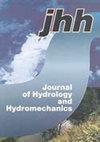Monthly stream temperatures along the Danube River: Statistical analysis and predictive modelling with incremental climate change scenarios
IF 2.4
4区 环境科学与生态学
Q3 WATER RESOURCES
引用次数: 0
Abstract
Abstract The aim of the study is to analyse changes and predict the course of mean monthly water temperatures of the Danube River at various locations for the future. The first part of the study involves conducting a statistical analysis of the annual and monthly average air temperatures, water temperatures, and discharges along the Danube River. The study examines long-term trends, changes in the trends, and multiannual variability in the time series. The second part of the study focuses on simulating the average monthly water temperatures using Seasonal Autoregressive Integrated Moving Average (SARIMA) models and nonlinear regression models (NonL), based on two RCP based incremental mean monthly air temperature scenarios. To assess the impact of future climate on stream temperatures, the historical long-term average of the monthly water temperature (1990–2020) was compared with scenarios S1 (2041–2070) and S2 (2071–2100). The simulation results from the two stochastic models, the SARIMA and NonL, showed that in scenario S1, the Danube River’s average monthly water temperature is projected to increase by 0.81/0.82°C (Passau), 0.55/0.71°C (Bratislava), and 0.68/0.56°C (Reni). In scenario S2, the models predict higher increases: 2.83/2.50°C (Passau), 2.06/2.46°C (Bratislava), and 2.52/1.90°C (Reni). Overall, the SARIMA model proved to be more stable and effective in simulating the increase in monthly water temperatures in the Danube River.多瑙河沿岸的月流温度:具有增量气候变化情景的统计分析和预测模型
摘要:本研究的目的是分析多瑙河在不同地点的月平均水温的变化和预测未来的过程。研究的第一部分包括对多瑙河沿岸的年和月平均气温、水温和排放量进行统计分析。该研究考察了长期趋势、趋势变化以及时间序列中的多年变率。研究的第二部分着重于利用季节自回归综合移动平均(SARIMA)模型和非线性回归模型(NonL)模拟两种基于RCP的月平均气温增量情景下的月平均水温。为了评估未来气候对河流温度的影响,将1990-2020年月水温的历史长期平均值与情景S1(2041-2070)和情景S2(2071-2100)进行了比较。SARIMA和NonL两个随机模式的模拟结果表明,在情景S1下,多瑙河月平均水温将分别升高0.81/0.82°C (Passau)、0.55/0.71°C (Bratislava)和0.68/0.56°C (Reni)。在情景S2中,模型预测的升温更高:2.83/2.50°C (Passau)、2.06/2.46°C (Bratislava)和2.52/1.90°C (Reni)。总体而言,SARIMA模型在模拟多瑙河月水温上升方面更为稳定和有效。
本文章由计算机程序翻译,如有差异,请以英文原文为准。
求助全文
约1分钟内获得全文
求助全文
来源期刊
CiteScore
4.20
自引率
5.30%
发文量
30
审稿时长
>12 weeks
期刊介绍:
JOURNAL OF HYDROLOGY AND HYDROMECHANICS is an international open access journal for the basic disciplines of water sciences. The scope of hydrology is limited to biohydrology, catchment hydrology and vadose zone hydrology, primarily of temperate zone. The hydromechanics covers theoretical, experimental and computational hydraulics and fluid mechanics in various fields, two- and multiphase flows, including non-Newtonian flow, and new frontiers in hydraulics. The journal is published quarterly in English. The types of contribution include: research and review articles, short communications and technical notes. The articles have been thoroughly peer reviewed by international specialists and promoted to researchers working in the same field.

 求助内容:
求助内容: 应助结果提醒方式:
应助结果提醒方式:


